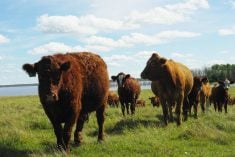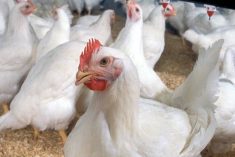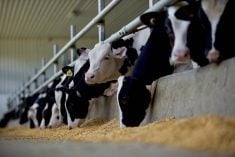ARBORG, Man. — Standing in front of a display table, Richard Grosshans grabbed a plastic bag filled with dried cubes that Mr. Magoo might have mistaken for shredded wheat cereal.
While edible, if desperate, the cubes are not made of wheat. They are 50 percent straw and 50 percent cattail.
“These are hybrid fuel cubes,” Grosshans said.
“(It) is essentially a biomass replacement for coal. It’s a densified or compressed product, so it’s easily fed into a biomass stoker boiler system and it creates an energy value that is equivalent to wood.”
Read Also

CBOT Weekly: China, shutdown guiding the market
The United States grain and oilseed markets are currently dominated by two factors, said Ryan Ettner, broker with Allendale Inc. in McHenry, Ill. Ettner said those are the absence of a trade deal with China and the ongoing United States government shutdown.
Grosshans, a research associate with the International Institute of Sustainable Development (IISD) in Winnipeg, has worked with cattails for several years:
He has two goals:
• Capture phosphorus before it enters Lake Winnipeg
• Prove the wetland plant can be harvested as a fuel source for bio-energy.
In early March, Grosshans provided an update of his efforts at a biomass workshop in Arborg.
Grosshans and his colleagues have focused on harvesting cattails from the Netley-Libau marsh, where the Red River enters Lake Winnipeg.
Cattails absorb nitrogen and phosphorus, but the plants eventually decompose and return the nutrients to the water. Harvesting the plant before it degrades could potentially reduce the amount of phosphorus entering Lake Winnipeg.
Grosshans’ research confirmed it is feasible, but in practice extremely difficult, to harvest a substantial amount of cattail from the marsh because water levels can change dramatically from day to day on Lake Winnipeg.
European engineers have designed specialized machinery for harvesting biomass from perpetually wet areas, but Grosshans has taken his cattail research in a different direction.
“There are cattails all over the (Lake Winnipeg) watershed, and those cattails are busily absorbing nutrients within the watershed,” he said.
“So instead of addressing the problem right at the mouth of the river … you can address these issues in the watershed … (and) remove those nutrients before they get downstream.”
For example, pastureland may be inundated with cattails in wet years.
“It’s these marginal land areas that farmers are constantly struggling to get value out of. These are very good areas for producing stuff like cattail,” Grosshans said.
“There’s a lot of cattail available in ditch wetland areas, (water) retention sites. Areas that are wet in the springtime but dry up in the fall.”
In 2012 and 2013, Grosshans and his colleagues harvested cattails from Pelly’s Lake, a wetland near Holland, Man.
With the help of Harvey Chorney, Prairie Agricultural Machinery Institute vice president in Manitoba, they adapted conventional hay harvesting methods and devised approaches suitable for cattails.
“The different technique we used this year (2013) was we used a disc mower conditioner,” Chorney said.
“It has rotary discs to be able to cut material instead of a sickle blade. It can go faster and quicker.”
The cattails are harvested after dry down with a large-square baler and then compressed into cubes or pellets, which can be burned in biomass burners and pellet stoves.
Grosshans said their experimentation on Pelly’s Lake suggests it’s possible to harvest cattail on a commercial scale.
“We really improved the efficiency, which means we improved the economics,” he said.
“By being able to do it more efficiently and on a larger scale … it really makes it economic feasible, just like straw bales or any other kind of harvesting.”
Eugene Gala, an engineer with Biovalco, which designs and installs biomass heating systems for commercial, agricultural and institutional applications, said cattails are an excellent source of fuel.
“We’ve done the testing … and it works beautifully,” he said.
“After the wood (pellets), cattails would be my next choice.”
The Manitoba company has installed solid fuel heating systems for more than 100 clients in North America, but cattail cubes aren’t yet available in commercial quantities.
Biomass demand is poised to expand rapidly because burning coal for heat will be prohibited in Manitoba as of June 30, 2017.
Seventy Hutterite colonies in Manitoba burn coal to heat barns, fabrication shops and other buildings. More broadly, the province is enthusiastically touting the potential of a biomass industry and is offering incentives to promote opportunities.
Grosshans said cattail cubes could become a major source of biomass fuel for Hutterites and other users because Manitoba has an abundant supply.
“It’s anywhere from two million up to five million tonnes annually available,” he said.
“Cattail could be looked as a bioenergy crop, but the great thing about cattail is you don’t have to plant it and it wants to grow.”
Cattails and the environment:
Cattail cubes may be a potential source of energy, but how will cutting and removing the wetland plant affect waterfowl and other wildlife?
Richard Grosshans, a research associate with the International Institute of Sustainable Development, says detrimental effects can be managed.
“Depending on when you harvest, there is a very sustainable and renewable way of harvesting cattail. If you harvest later in the fall, you can avoid wildlife impacts.”
In fact, removing cattail and using it to make biomass cubes is a way to control a highly competitive plant.
“You’re removing this species that grows very aggressively and … chokes out other species,” he said.
“(It) tends to create these patches of wetland with no open water, which is not very good for wildlife.”















